Daredevils of Niagara | Karel Soucek
Karel Soucek didn’t just want to take his place among the exclusive list of Niagara Falls daredevils. As he started his stunting career at the falls, Soucek announced — – and emblazoned on all his barrels – that he was “the last of the Niagara daredevils.”
Name: Karel Soucek
Age: 37
Hometown: Czechoslovakia
Stunt: Rode a barrel over the Horseshoe Falls
Date: July 4, 1984
Outcome: Survived but died in a recreation of the stunt seven months later at the Houston Astrodome
Before the plunge, Soucek announced that if anyone else went over the falls after he did, he would go over again and again, each time reclaiming the title.
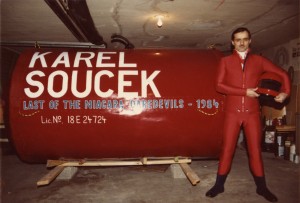
Karel Soucek by barrel
Soucek could not have predicted the flood of daredevils who performed stunts at the falls in the 1980s and 1990s – Steve Trotter, Dave Munday, Peter DiBernardi and Jeffrey Petkovich, and Trotter again with Lori Martin.
And he could not have predicted that a much more controlled stunt during a thrill show in the Houston Astrodome seven months later would take his life.
It was a sad and ironic death for Soucek, a 5-foot-6, 140-pound dynamo who compiled an extensive list of stunts. Starting as a motocross racer in Czechoslovakia, he became a licensed pilot, stunt flier, wing walker and skydiver. He also made many daring motorcycle jumps, including one over 22 cars. He earned his Canadian citizenship and lived in Stoney Creek, Ont., not far from Hamilton, so it is perhaps inevitable that his attention would turn to Niagara Falls.
Soucek started by shooting the Whirlpool Rapids below the falls in a metal barrel in 1977. In an unusual stunt that evoked the spirit of the tightrope-walkers of the 1800s, on July 22, 1976, Soucek placed a modified moped on the cables that support the Spanish Aero Car that spans the gorge. He rode the moped some 20 feet when a bolt on the wire jarred it loose. Soucek was saved from falling into the water by a safety harness he prudently wore.
But Soucek knew that to secure lasting fame, he had to take the plunge over the 176-foot Horseshoe Falls. In the summer of 1983, he announced at a speedway near Hamilton that he would go over the Horseshoe. Soucek said he had told so many people for so long of his intentions that it was time for him to “put up or shut up.”
For the next year, Soucek worked on his barrel and tested the falls. He reportedly put several test barrels into the water above the falls, finally settling on a spot just 1,000 feet above the brink as being the one that would place the barrel where he wanted it for maximum safety.
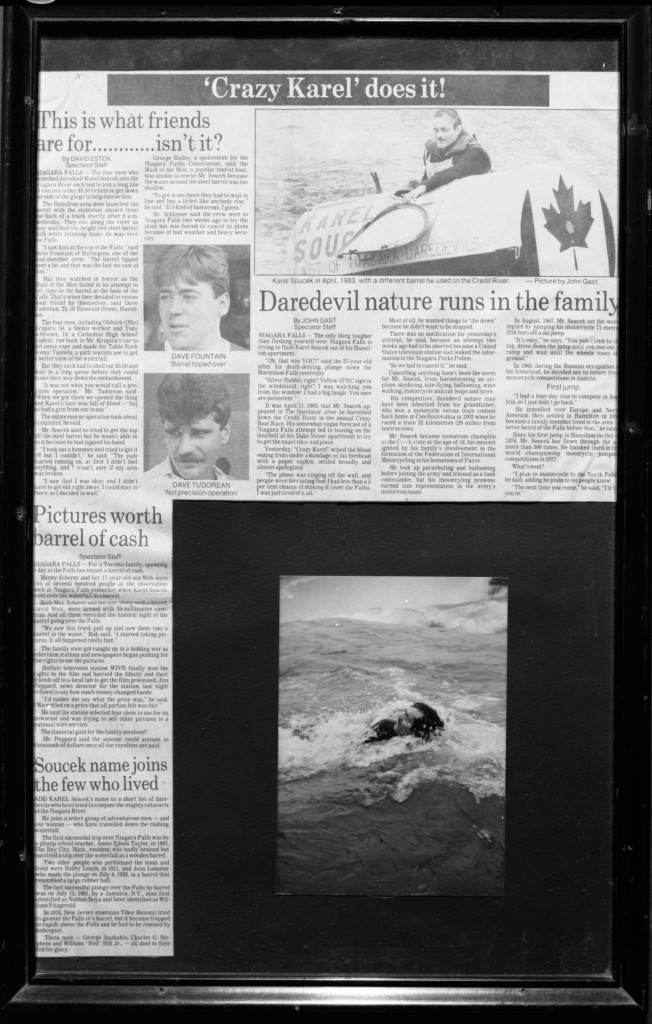
Karel Soucek news item
At 9:30 a.m. on July 2, wearing a brightly colored jumpsuit, Soucek took the plunge. His red and white barrel was lettered with the words “Karel Soucek Last of the Niagara Daredevils.” He was the first person to ride a barrel over the Horseshoe Falls in 23 years; the only other surviving barrel-rider was William FitzGerald, who gave the name Nathan Boya when he was pulled from his Plunge-O-Sphere.
The list of daredevils was short, and with his successful stunt, Soucek was at the top of it.
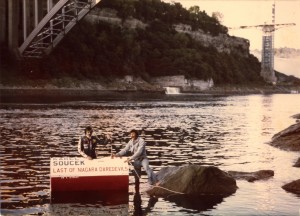
Soucek Emerging from his barrel
After his barrel was recovered below the falls, Soucek was taken to a hospital and treated for an injury to his left wrist and a cut on his forehead. During a news conference later that day in a hotel near the falls, Soucek said he had decided at the last minute not to wear a helmet because of the stifling heat inside the barrel. On his left arm, he wore two watches, a compass and a flashlight, and at the moment of impact, his arm flew up and hit him in the face. As blood from the cut trickled down his forehead, Soucek downplayed the effect of the impact. “I’ve hit concrete walls at greater speeds than that,” he said.
Soucek was cited for illegally performing a stunt and paid a $500 fine in Ontario Provincial Court.
Seven months later, he showed up at the Houston Astrodome with a new wooden barrel, 8½ feet tall and 5 feet in diameter. Bound with nine metal bands, it resembled the barrel Annie Edson Taylor used to go over the falls in 1901.
As the climax of the Thrill Show and Destruction Derby, the wooden barrel was to be dropped 180 feet from the roof of the Astrodome into a tank of water 12 feet in diameter and 9 feet deep. Two test drops earlier in the day produced chilling results – in one, a weighted barrel slightly smaller than the real one landed perfectly; in the other, it missed the tank entirely and smashed onto the floor.
Later, Evel Knievel and others who attended the show said they had tried to talk Soucek out of the stunt. Knievel called it “the most dangerous stunt I’ve ever seen.”
Around 11 p.m., the barrel was hoisted to the top of the Astrodome, and Soucek, described as looking “composed though slightly apprehensive,’ climbed in from a catwalk. Crew members nailed on the hatch, which appeared to observers to be a piece of plywood. Then the announcer led the crowd of 40,000 in a countdown from 10 to zero, at which point the barrel was supposed to drop. Instead, nothing happened. A moment of confused silence from the crowd was followed by nervous laughter and scattered boos.
A crew member later said there were problems stabilizing the barrel for the drop. “It started spinning real bad, and this kept on for some time,” he said. The announcer led the crowd again in a countdown from five. The crew member said, “But after a while the people started getting so impatient that we went ahead and dropped him. Just as we started to release the barrel, it started spinning again.”
At zero, the barrel dropped. It struck the side of the tank severely damaging the barrel, which fell, lopsided, into the water.
Accounts vary about how long it took the crew to get the barrel out of the tank – some say five minutes – and then to get Soucek out – some say 10 to 15. Other reports say it took closer to 30 minutes to free Soucek. He was conscious and talking when he was taken out of the barrel. But, suffering from a fractured skull and crushed chest, he died a few minutes after midnight, an hour after the terrible impact.
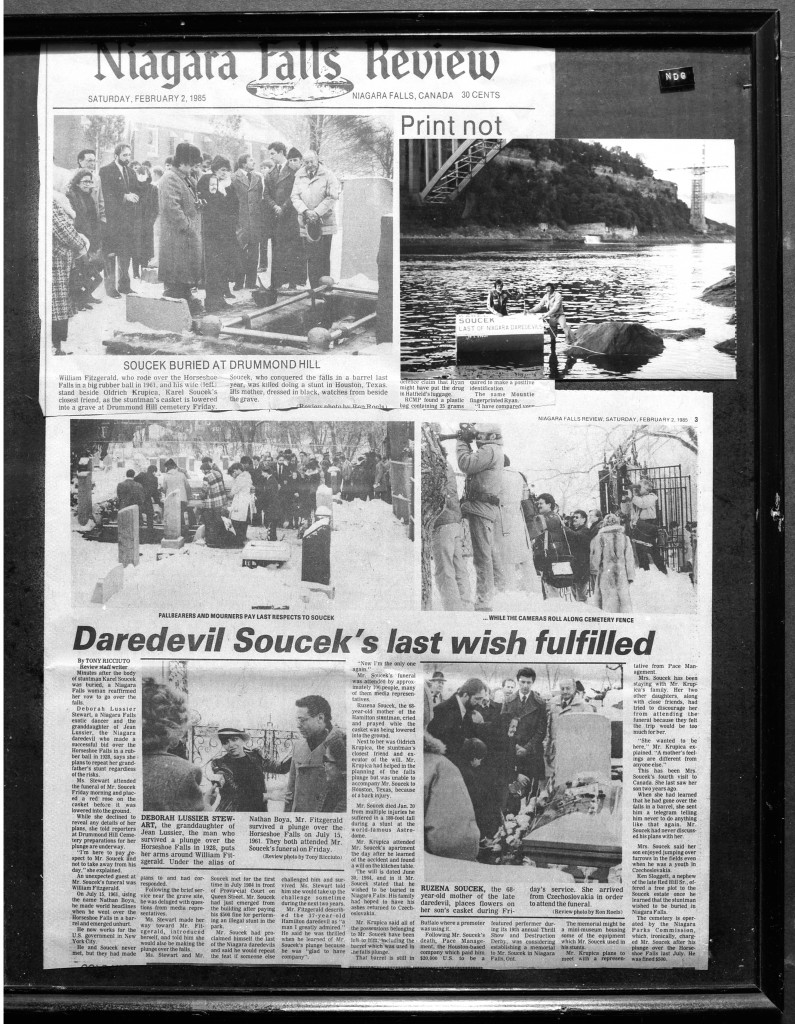
Karel Soucek death writeup
Soucek had no family in North America. His devastated mother, Ruzena Soucek, made the trip from Czechoslovakia for his funeral. Draped in black, she was the image of grief as she walked to the grave of her only son in Drummond Hill Cemetery, close to the falls.
Holding her arm on the snowy ground was Nathan Fitzgerald, who had been the only living Niagara Falls barrel-rider from 1961 to 1984 and was again the sole survivor. He and Soucek had communicated by letter but never met. Still FitzGerald felt a strong bond with the man who had challenged the falls and survived, as he had.
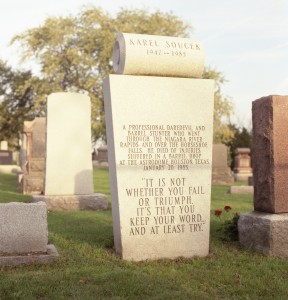 In flowers he sent to the gravesite, FitzGerald attached this note: “To a Fallen Comrade: I had so wanted to meet you, yet it wasn’t to be. We had something in common and those Falls are still tumbling there. That I’ve lived to tell the tale is a miracle. Fate has taken a hand and your life has ended too soon, but I doubt you would have wanted it any other way.”
In flowers he sent to the gravesite, FitzGerald attached this note: “To a Fallen Comrade: I had so wanted to meet you, yet it wasn’t to be. We had something in common and those Falls are still tumbling there. That I’ve lived to tell the tale is a miracle. Fate has taken a hand and your life has ended too soon, but I doubt you would have wanted it any other way.”
On the handsome gravestone, topped by a barrel, an image of Soucek is engraved on the face of the falls, along with his motto, “It’s not whether you fail or triumph; it’s that you keep your word and at least try.”

Leave a Reply
Want to join the discussion?Feel free to contribute!